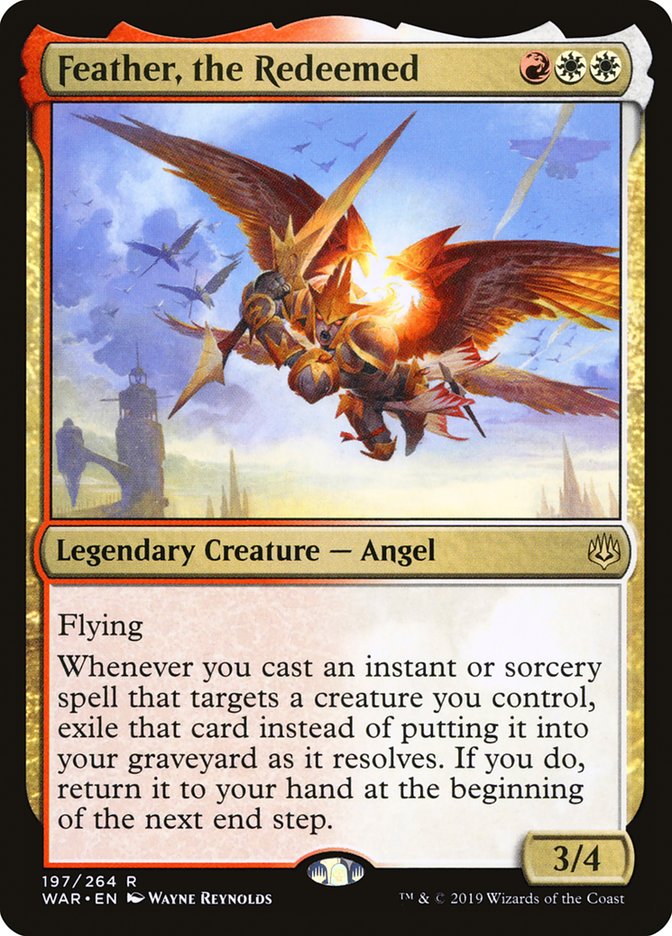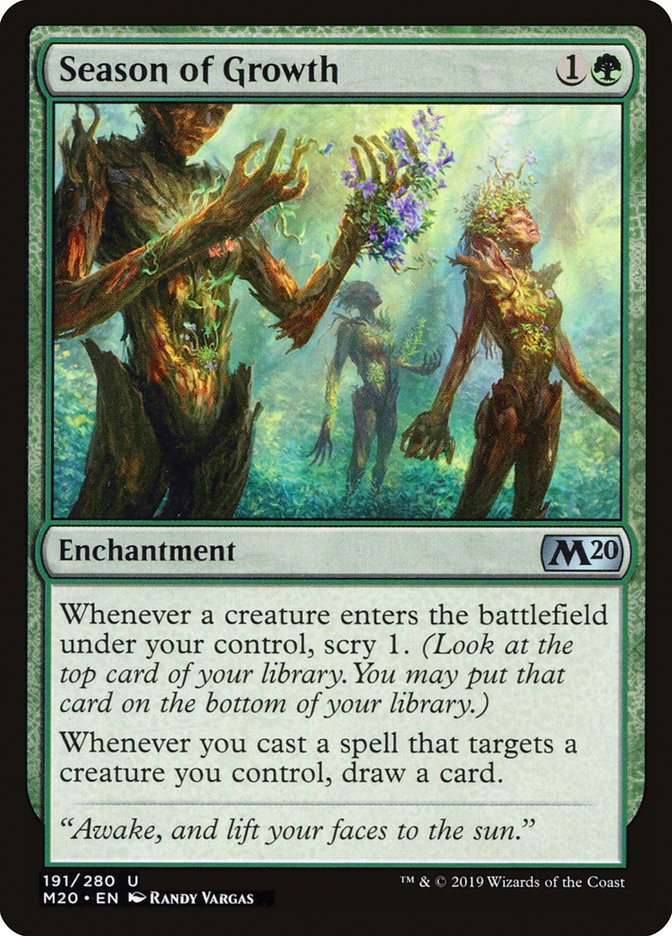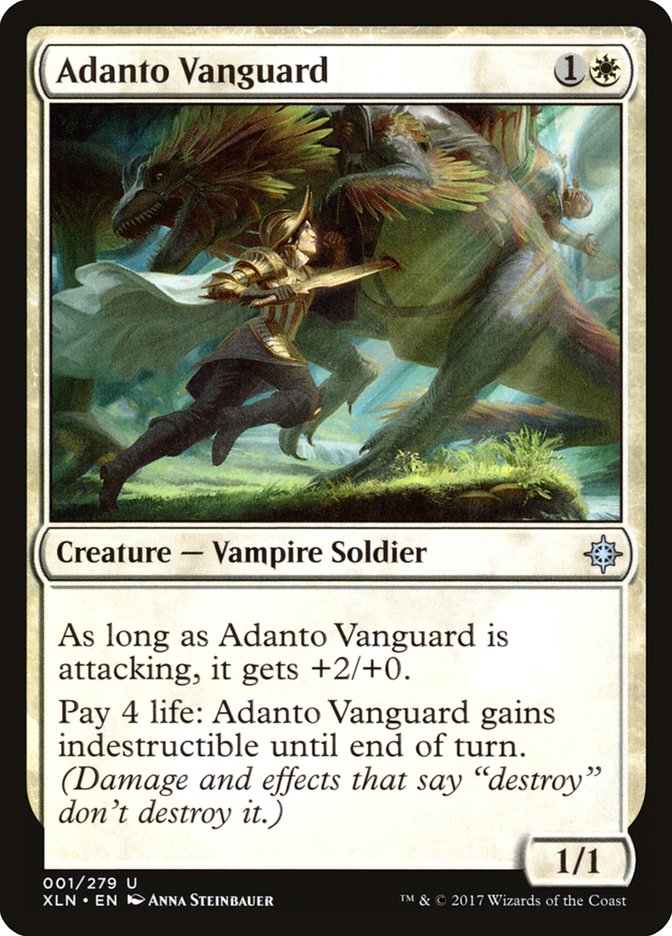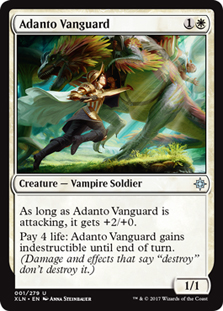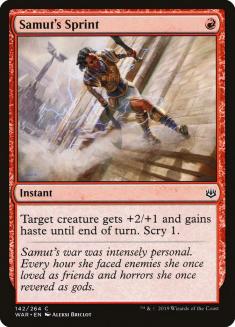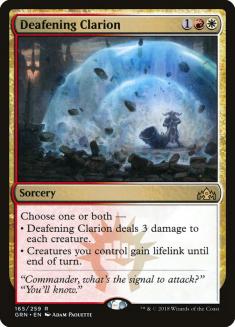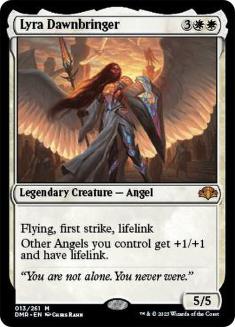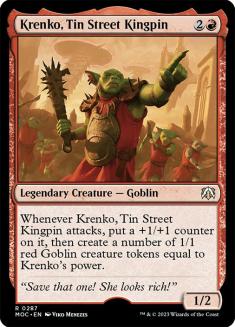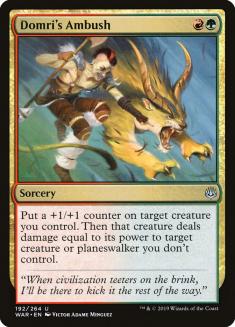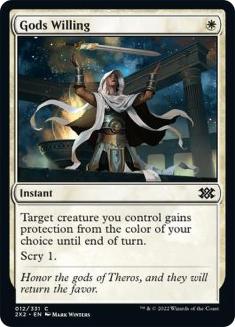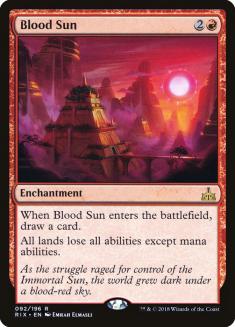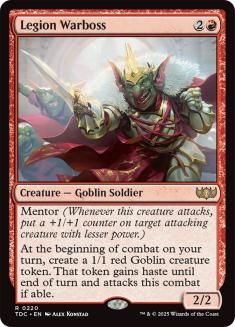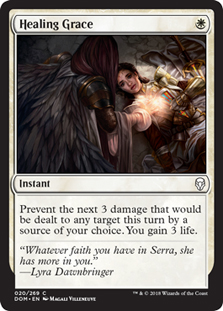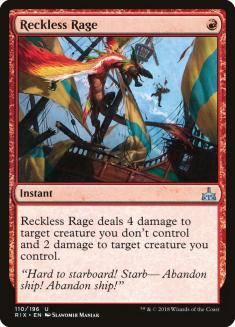Decks based around Feather, the Redeemed may look like meme decks, but I promise you that they’re real and well-positioned right now in Core Set 2020 Standard – one just won the Magic Online MCQ, for example. In today’s article, I’ll go over what I consider to be the best version of the deck, sideboarding against the most common matchups, and some tips and tricks.
When Should You Play Feather?
On the surface, Feather looks like an aggressive deck. After all, the color combination is usually associated with aggressive builds (either Boros or Naya) and it’s playing creatures and pump spells. This might make you think it’s a good choice for an unknown field, as aggressive decks with a proactive gameplan usually are, but that’s not true. Feather is ultimately a metagame deck with polarized win rates, and you should only play it if you expect the metagame to be right for it.
If your opponents are trying to win with their own creatures, this is where Feather shines. People who are trying to build their own gameplan are usually too busy to be able to remove your creatures, and once you establish your combos, you can machine-gun everything down while protecting all your pieces and it doesn’t matter what they do. Decks like Orzhov Vampires (or other aggressive white-based decks), Elementals, creature-based Bant Ramp, and Mono-Red Aggro are usually good matchups.
If your opponent is not creature-based, you’re in trouble because either you can’t interact with their gameplan at all (for example, Simic Nexus) or their gameplan is to stop your gameplan from happening with removal spells (for example, Esper Control). You make it easy for them by being so threat-light, since a lot of your deck is taken up by removal and tricks.
Right now, Core Set 2020 Standard seems to be in a rock-paper-scissors state. The white aggressive decks (Orzhov Vampires) beat the slower decks (Bant Scapeshift, Simic Nexus), which then beat the midrange decks with some removal, which in turn beat Vampires. Feather is a “midrange with removal” deck that is good versus other midrange decks. If you expect the metagame to be full of creatures, you should play Feather; if not, you shouldn’t.
Personally, I expect Orzhov Vampires to be the default deck to beat in Core Set 2020 Standard, at least for the time being. In this week’s MPL Split, a whopping 75% of the decks were Orzhov Vampires (granted, that was only six decks, but still), and MPL competitors Autumn Burchett and Brad Nelson both tweeted saying they thought Orzhov Vampires was the clear best deck:
My MPL Pearl Division decklist is Vampires, which feels like pretty clearly the best archetype in standard to me. Very excited to battle with it and drain all the blood from my opposition ♀️ @ArenaDecklists pic.twitter.com/0X3Jq5GgWP
— Autumn Burchett (@AutumnLilyMTG) August 5, 2019
After a weekend of trying to beat this deck, I ended up just submitting it for MPL Weekly. Just played my first match against @ChrHauck and got slaughtered in embarrassing fashion.
I don’t think I’ll ever beat vampires which is bad since almost everyone is playing it. pic.twitter.com/8tX6pC3TPn
— Brad Nelson (@fffreakmtg) August 5, 2019
If Brad and Autumn are right, this seems like the perfect moment for Feather to succeed.
Naya or Boros?
The most popular build of Feather is Boros. For reference, here’s the list that won the latest Magic Online MCQ:
Creatures (19)
- 4 Adanto Vanguard
- 3 Legion Warboss
- 4 Dreadhorde Arcanist
- 4 Tenth District Legionnaire
- 4 Feather, the Redeemed
Lands (22)
Spells (19)
Sideboard

The other, less popular version splashes green. You can play a variety of green cards, but Season of Growth justifies the splash.
Naya is, in my opinion, the superior build of Feather. After playing with both versions, I believe the pros of playing green outweigh the cons, and I honestly cannot tell you why this isn’t a more popular stance. This is my latest list:
Creatures (15)
- 2 Adanto Vanguard
- 4 Dreadhorde Arcanist
- 4 Tenth District Legionnaire
- 1 Krenko, Tin Street Kingpin
- 4 Feather, the Redeemed
Lands (22)
Spells (23)
- 2 Shock
- 4 Gods Willing
- 4 Defiant Strike
- 4 Reckless Rage
- 2 Collision
- 1 Samut's Sprint
- 2 Domri's Ambush
- 4 Season of Growth
Sideboard

This isn’t your typical aggressive deck, as it takes a little to start doing anything (you have no one-drops and sometimes your Turn 2 is an enchantment). Once you get going, though, it can be a lot of fun and more powerful and explosive than it appears at first glance. The spells in the deck are all cheap, so you don’t need to get desperate if it appears you’re falling behind, as there is a lot of comeback potential; I’ve won several games against Orzhov Vampires in which my first play of the game was a Turn 3 Feather, the Redeemed, for example, as once you assemble your cards it becomes hard for them to do anything, and a 3/4 flier does an admirable job of blocking and killing planeswalkers.
Playing green doesn’t come without costs, of course. First, your mana is meaningfully worse, not in an “I can’t cast any of my spells” kind of way but in an “I’m taking so much damage every game” kind of way. This is a real problem, but luckily for us the decks that punish you for lowering your life total (which is mostly Mono-Red Aggro) seem to be down in popularity; most other decks can deal twenty damage just as easily as they can deal sixteen, as they attack in large chunks. Second, you’re adding a card that has the potential to do literally nothing to a deck that’s already trying desperately to find all the pieces in its combination.
Feather decks are all about a healthy balance in your draws. You need lands to cast your spells, you need a creature, and you need spells that target that creature. You’re doomed to lose any game in which you don’t find a creature, and, though it’s possible to win the game with just creatures, it’s not likely. Season of Growth is not a land, not a creature, and not a spell that targets your creatures, so by adding it to your deck you’re increasing your fail rate even more.
What Season of Growth does, though, is make sure that, once you do cross that first barrier of finding lands plus creature plus spell, you become overwhelmingly more likely to win. In my experience, you almost never lose games because you literally didn’t draw a single creature or a single spell; rather, you lose because you draw one creature and they kill it, or you lose because you draw one spell and it’s either not enough or not the right spell. Season of Growth means that extra creatures become spells (due to scrying) and that extra spells become creatures (due to the card drawing). It makes you much more likely to grind through removal spells and it also means you’re almost guaranteed to find a specific spell that you’re looking for (usually Reckless Rage, but sometimes Gods Willing) sooner rather than later.
The card I’m least happy about is Adanto Vanguard. This is not really an aggressive deck in the traditional sense, so you’re not interested in a 3/1 attacker a lot of the time. That said, you need some early creature in this slot, since you need something to pump or Reckless Rage and Adanto Vanguard is a resilient creature that you can target without fear they’re going to respond by killing it. Right now I think Adanto Vanguard is the best we have, but Tomik, Distinguished Advokist is an option if Nissa, Who Shakes the World is popular.
Matchups
VS Orzhov Vampires
This is a good matchup because they are a creature deck that cannot disrupt you, which is exactly what you prey on. Feather is incredibly resilient, as it cannot be killed by Cast Down, Legion’s End, or Sorin, Imperious Bloodlord.
Out:
In:
They usually bring in Noxious Grasp, which kills Lyra, but I think it’s still worth bringing in as it doesn’t die to anything else. Krenko dodges Cast Down and Noxious Grasp, so I like it here.
VS Bant Scapeshift
This is not a good matchup, but it’s not as bad as it looks because their regular plan is really inefficient against you. Bant Scapeshift is a good deck because, if it doesn’t Scapeshift people, it can still win with some Zombies and Hydroid Krasis. Fortunately, your deck is very good at beating that part of their deck, so it really is Scapeshift or bust for them. The main issue is that a lot of your hands are quite bad versus them, and if you don’t know what they are playing, you’re going to keep them because they are good hands versus the majority of the field.
Out:
In:
Since it’s Scapeshift or bust, you can actually dedicate some cards to fighting just that. I like Blood Sun more than Alpine Moon because it cantrips (which is especially relevant if they bounce it with Teferi, Time Reveler or get rid of it with Deputy of Detention) and because it randomly shuts off Temples and Blast Zone. There is an overload on cards that cost three, so perhaps one Blood Sun can become an Alpine Moon, but I’ve been happy with them so far. Fry isn’t a spectacular card by any means, but it kills Deputy of Detention, Teferi, and Hydroid Krasis, so I think it’s better than Shock.
VS Feather decks
Game 1 of this matchup is slightly advantageous for you because Season of Growth is a good card and because Collision // Colossus is extra Feather removal, but it’s still all about being on the play and drawing the right combination of cards.
Out:
In:
Sideboarded games are better for you because there are more removal spells from both sides, which means the anti-attrition aspect of Season of Growth has time to shine. I also play two Healing Graces that most people don’t play and I think they are quite good in this matchup.
VS Mono-Red Aggro
This is also a favorable matchup, as they have trouble killing Feather. A very fast draw and Experimental Frenzy are their best bets.
Out:
In:
VS Temur Elementals
I believe Elemental decks are good matchups because they can’t kill your creatures reliably and you can stifle their early development. Once you assemble Feather plus removal spell plus protection spell, most Elemental decks have nothing to go over the top of you – even if they draw a bunch of extra cards, they’re just not drawing into anything.
Out:
In:
VS Esper Midrange
This is a bad matchup because the combination of discard spells, removal spells and Teferis is brutal. You’re trying to assemble a combo and all the cards in their deck stop you.
Out:
In:
You can sideboard in good cards, but they will have good cards too – Duress and Noxious Grasp, to name a couple – so it’s still a bad matchup.
VS Simic Nexus
This is your worst matchup. They go completely over the top of you and all your removal is dead. Much like versus Bant Scapeshift, if you don’t know what they’re playing, you’re likely to keep a hand that doesn’t do anything. This is a matchup where having the green splash hurts you, since the Boros version is at least a little faster with Gird for Battle.
Out:
In:
Sideboarded games don’t improve for you because there’s no card like Blood Sun that you can bring. Your best hope is to race them, but that can only happen if they keep a particularly bad draw, as every Root Snare is just a Time Walk. You have more bad cards in your deck (extras of the ones you’re taking out, Domri’s Ambush), but there’s simply nothing to bring in. The MCQ winner had Demystify in the sideboard, which would be good here, but I don’t like it, as it’s only for this matchup and the matchup is still bad.
Tips and Tricks
- If you have Feather, The Redeemer out, you want to do things at the end of your opponent’s second main phase, rather than at the end of the turn, so that your spells are back in your hand on your turn. If you’re playing in person, you need to say “at the end of your second main phase,” and if you’re playing online, you need to set a specific stop, otherwise it won’t give you priority. Be careful, though, as this stops the opponent from ending their main phase, which means they can actually cast sorcery-speed spells, even though they theoretically passed the turn to you already.
- You will often have a choice on how to stack scrys and card drawing, especially once you have Tenth District Legionnaire and Season of Growth on the battlefield. Here’s the general heuristic I use:
- If you already know the top card and you want it, draw it before you scry again, as otherwise you waste the scry.
- If you aren’t looking for anything specific (because you’re tapped out, for example, or because you already have your next play mapped out), you want to draw first and then scry. You do this because it gives you the maximum amount of information to decide on your scry. If you scry first, you could see, for example, a land; you want that, so you keep it and draw it. Then, on your draw step, you draw a second land and it turns out you didn’t need the first one to begin with, but by then it’s too late. If you simply draw the card, you will see the second land and know that it’s redundant.
- If you’re looking for something specific, do the opposite: scry as much as you can before your last draw so you have the highest chance of finding it.
- If you’re looking for multiple things, stagger scrys and draws so you never need to scry a second time for a card you want to keep. Remember that each trigger resolves separately, so you can cast things in the middle of the sequence.
- The protection from Gods Willing is very useful as a way to push through blockers, but it can also backfire horribly if you’re still in the middle of pumping and choose the wrong color. For example, if you give a creature protection from red, you can no longer target it with Collision // Colossus or Reckless Rage, and if you give it protection from white, you can’t use Defiant Strike and future Gods Willings. If you’re giving a creature protection from multiple colors and one of them is white, white has to be the last one. This leads to some interesting scenarios where you have to respond to your own spells, which is also tricky to do online (you need full control mode for this).
For example, imagine you have a Feather and your opponent casts Fry on it. If you have Reckless Rage and Gods Willing, the correct play is to cast Reckless Rage, hold priority, and then cast the Gods Willing. The Reckless Rage has two targets, so it will still resolve even if your creature has protection from red. - Dreadhorde Arcanist interacts in a funny way with Feather. If you have both out, the card comes back to your hand rather than being exiled after the Arcanist casts it, which means you can start looping it again. This can also be useful when you have a Shock in your graveyard but don’t want to cast it right now. You can simply Shock one of your own creatures with the Arcanist and then it’ll come back to your hand as it resolves.
You should also keep in mind that having Feather out means you cannot cast a spell and immediately recast it with Arcanist, as the effect is not optional and it will not go to your graveyard. This is very easy to forget in the middle of complicated turns. What you can do, however, is discard a spell to hand size (or have it fizzle in some other way, but discarding to hand size is very common with this deck when you’re drawing so many cards and a lot of your spells come back) and then cast it with Arcanist. - Collision // Colossus costs four mana in your graveyard if you want to recast it with Dreadhorde Arcanist, which means most of the time you have to target the Arcanist first with Colossus and then recast it.
- The deck attacks for surprisingly high amounts of damage, especially when Tenth District Legionnaire is involved. When you get to the middle of the game, you should always keep in mind how much you can actually attack for. Basically, don’t be lazy and do the math. You might find out you just have lethal.
- When you get Feather plus something going, it’s usually better to protect the combo than to try to get a bigger advantage for one turn. For example, if my opponent has a lot of open mana, I’d rather not cast a Defiant Strike to keep up Gods Willing. If they have something, I wasted a card (or potentially two), but if they have nothing, I’m not likely to need that card anyway.
- Keep in mind that Dreadhorde Arcanist does not work against an opposing Teferi, Time Reveler. That’s one of the reasons that card is so infuriatingly good against you.
If you haven’t played Naya Feather before, I urge you to give it a try. It’s competitive and well-positioned right now, and it’s also incredibly satisfying to play. The first time you play a Defiant Strike on a Dreadhorde Arcanist with Season of Growth on the battlefield and realize you’ve just cast a one-mana Tidings, you’ll probably be as hooked as I am.


